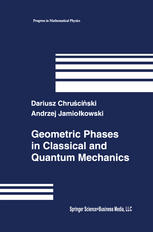

Most ebook files are in PDF format, so you can easily read them using various software such as Foxit Reader or directly on the Google Chrome browser.
Some ebook files are released by publishers in other formats such as .awz, .mobi, .epub, .fb2, etc. You may need to install specific software to read these formats on mobile/PC, such as Calibre.
Please read the tutorial at this link: https://ebookbell.com/faq
We offer FREE conversion to the popular formats you request; however, this may take some time. Therefore, right after payment, please email us, and we will try to provide the service as quickly as possible.
For some exceptional file formats or broken links (if any), please refrain from opening any disputes. Instead, email us first, and we will try to assist within a maximum of 6 hours.
EbookBell Team

4.7
16 reviewsThis work examines the beautiful and important physical concept known as the 'geometric phase,' bringing together different physical phenomena under a unified mathematical and physical scheme.
Several well-established geometric and topological methods underscore the mathematical treatment of the subject, emphasizing a coherent perspective at a rather sophisticated level. What is unique in this text is that both the quantum and classical phases are studied from a geometric point of view, providing valuable insights into their relationship that have not been previously emphasized at the textbook level.
Key Topics and Features:
• Background material presents basic mathematical tools on manifolds and differential forms.
• Topological invariants (Chern classes and homotopy theory) are explained in simple and concrete language, with emphasis on physical applications.
• Berry's adiabatic phase and its generalization are introduced.
• Systematic exposition treats different geometries (e.g., symplectic and metric structures) living on a quantum phase space, in connection with both abelian and nonabelian phases.
• Quantum mechanics is presented as classical Hamiltonian dynamics on a projective Hilbert space.
• Hannay’s classical adiabatic phase and angles are explained.
• Review of Berry and Robbins' revolutionary approach to spin-statistics.
• A chapter on Examples and Applications paves the way for ongoing studies of geometric phases.
• Problems at the end of each chapter.
• Extended bibliography and index.
Graduate students in mathematics with some prior knowledge of quantum mechanics will learn about a class of applications of differential geometry and geometric methods in quantum theory. Physicists and graduate students in physics will learn techniques of differential geometry in an applied context.